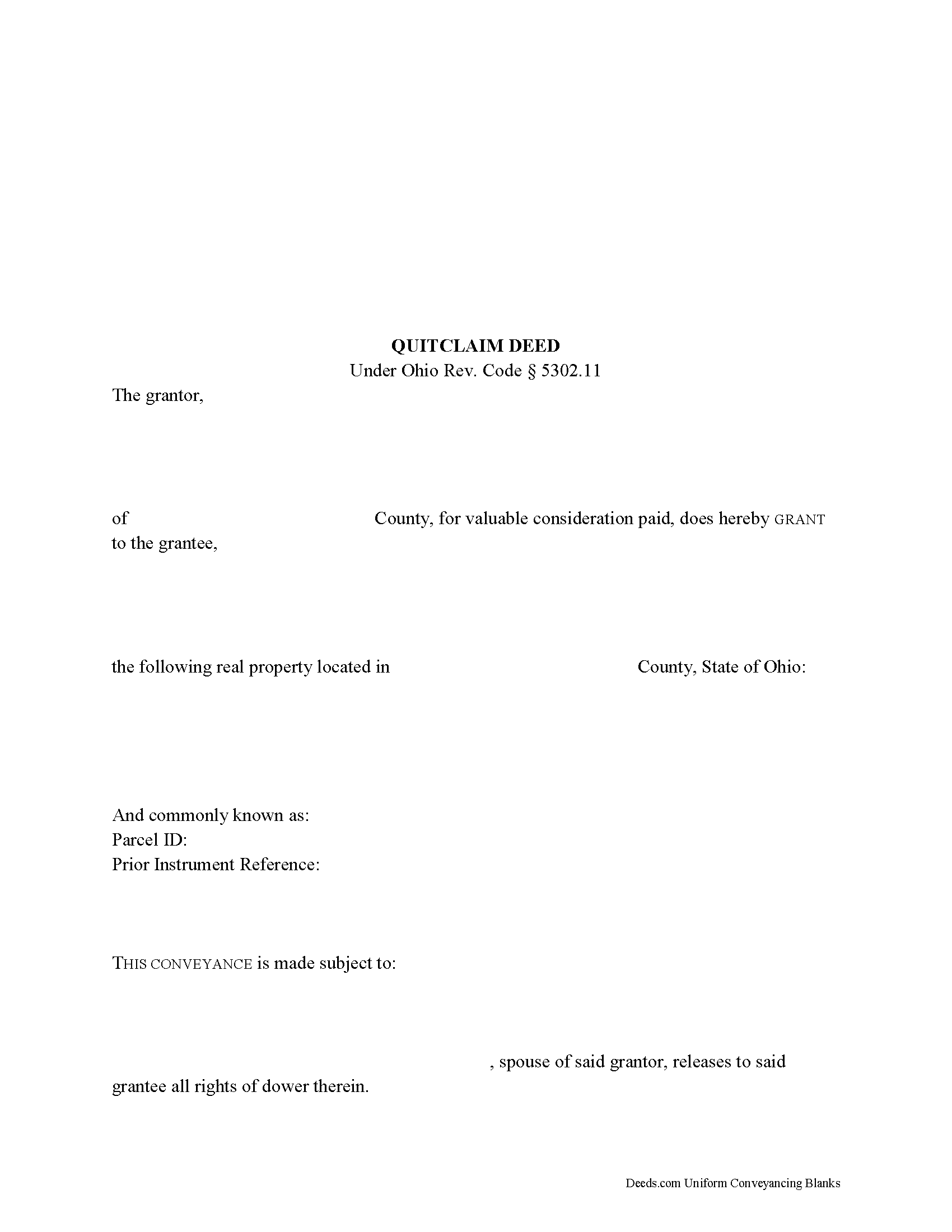Download Ohio Quitclaim Deed Legal Forms

Ohio Quitclaim Deed Overview

In Ohio, title to real property can be transferred from one party to another by executing a quitclaim deed. Quitclaim deeds are statutory in Ohio under Ohio Rev. Code Section 5302.11, and they convey all the right, title, and interest of the grantor to and in the property (Ohio Rev. Code Section 5302.11). This type of deed "simply conveys whatever interest exists when the deed is executed (transferred) and delivered," and does not guarantee that the grantor has "good title or ownership."
Quitclaim deeds offer no warranties of title and provide the least amount of protection for the grantee (buyer). Generally reserved for divorces, clearing titles, and transfers of property between family members, quitclaim deeds do not offer the same assurances as general warranty deeds, which convey real property with the most guarantees of title, or limited warranty deeds, which only contain a promise to defend the title against claims that arose during the time the grantor held title to the property.
In Ohio, a lawful quitclaim deed includes the grantor's full name, mailing address, and marital status; the statement "for valuable consideration paid"; and the grantee's full name, mailing address, marital status, and vesting. Vesting describes how the grantee holds title to the property. Generally, real property is owned in either sole ownership or in co-ownership. For Ohio residential property, the primary methods for holding title in co-ownership are tenancy in common and survivorship tenancy. An estate conveyed to two or more people is considered a tenancy in common, unless a survivorship tenancy is declared (Ohio Rev. Code Section 5302.20(a)).
As with any conveyance of realty, a quitclaim deed requires a complete legal description of the parcel. Contact the county auditor to verify the legal description prior to recording. In Ohio, any deeds that modify a legal description or contain a new legal description require the name and address of the surveyor who created the legal description (Ohio Rev. Code Section 5301.25(B)). All new metes and bounds descriptions prepared by a registered surveyor must be accompanied by a signed and sealed plat of survey.
Ohio law requires deeds to include a reference to the instrument granting title to the current grantor (Ohio Rev. Code Section 5301.011). That document's volume and page or instrument number should appear on the face of the deed, as well as the county where the document is filed.
Ohio recognizes dower rights, which means that if a married man or woman owns an interest in real property, his or her spouse holds a 1/3 interest in it (Ohio Rev. Code Section 2103.02). As such, if the grantor is married and his or her spouse retains dower rights to the property being conveyed, the spouse must relinquish his or her dower rights. If applicable, the spouse's name should appear on the face of the deed. Consult a lawyer with questions regarding dower rights and release.
Detail any restrictions associated with the property, ensure that the form meets all state and local standards for recorded documents, and sign the deed in the presence of a notary public or other authorized official. Submit the deed to the appropriate county auditor's office prior to recording so that the owner's name can be transferred on the county's tax list (Ohio Rev. Code Section 319.20).
Record the deed at the recorder's office in the county where the property is located for a valid transfer. Contact the same office to confirm accepted forms of payment. A Conveyance Fee Statement (Form DTE 100, or DTE 100EX if claiming an exemption) must be signed by the grantee and filed with the deed.
This article is provided for informational purposes only and is not a substitute for legal advice. Contact an attorney with questions about quitclaim deeds, or for any other issues related to the transfer of real property in Ohio.
(Ohio QD Package includes form, guidelines, and completed example)